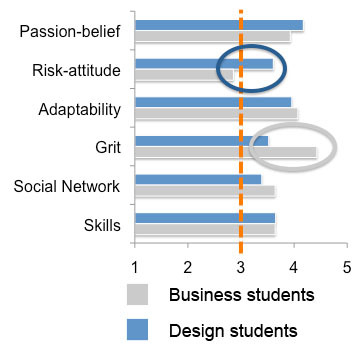Entrepreneurs are the people who reinvent and revigorate our society in large and small ways and we know them by their actions. However, how do entrepreneurs with a business or a design background differ from one another and what are their personal traits?
We all remember that kid in school who just could not sit still and who always had some project going to make extra money. If not high school, then in college, he had a small company and could be found taking orders out of his dorm room or his father's basement. As stated above, those with an entrepreneurial spirit identify themselves by their actions.
Studying and conducting design-a-thons on Design Driven Startups, we identified six key entrepreneurial traits: Belief/Passion, Risk-attitude, Adaptability, Grit, Social network and Skill. We then had both business and design students self-assess their personal performance on these traits, and found grit and risk to be the dividing factors. Business students perceive themselves as having more grit than design students and also being more risk-adverse than design students.
In psychology, grit is defined as perseverance and passion for long-term goals and has been found to account for an average of four percent of the variance in success outcomes. Grit is not related to IQ and demonstrates incremental predictive validity of success measures over and above IQ (A. W. Duckworth et al.)
Risk is the potential of losing something valuable, such as physical health, social status, emotional wellbeing or financial wealth. One can either be 'risk-seeking,' 'risk-neutral' or 'risk-averse.' Risk aversion is one's reluctance to accept a deal with an uncertain payoff as compared to another with a more certain, if lower, expected payoff.
Does this mean that a lack of grit and risk-seeking behavior in designers is holding design entrepreneurs back and perhaps preventing them from succeeding? Few firms founded by designers make it top the top, although, Dyson, AirBnB and Disney would be exceptions to that rule.
Of all the US students graduating with a bachelor degree in year 2010-2011, 365,000 graduated in the field of business and only 1,600 in industrial design. This means there are four industrial design graduates for every thousand business graduates and there may be many more business entrepreneurs than design entrepreneurs.
What about the business students who see themselves as having more grit than the design students, does this make them more successful in general? Does the business students' risk-aversion create a more leveled performance and the designers' risk-seeking make their performance more erratic?
Though failure is more acceptable in the U.S. than most other cultures, bad news tends to spread three times more quickly than good news, thus, hurting one's reputation in the process. Designers' have fewer objective quantitative performance metrics and rely on their reputation for respect. Thus, they may be more vulnerable to risk-taking and the resulting setbacks from events outside their control.
When it came to Belief/Passion, Adaptability, Social network and Skill, business and design students both felt that they were above average. This is normal human behavior since, for example, studies of drivers' self-perception show that most see themselves as being above average.
Thus, a slightly inflated entrepreneurial perception can also inadvertently affect performance. This, combined with lower grit and higher risk-seeking behavior, tips the odds and makes for a higher failure rate among design entrepreneurs. In other words, a large portion of entrepreneurial designers may not have any business being one and it may better serve them to know that than not to know.
